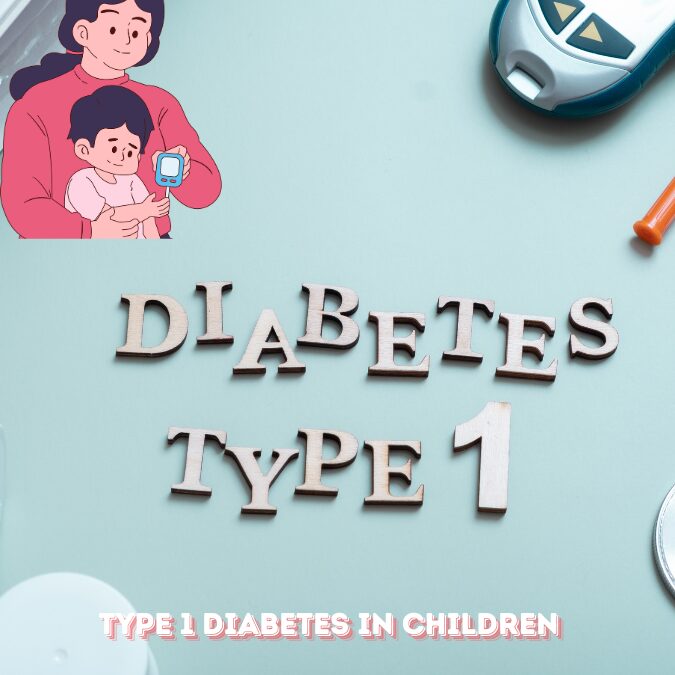Type 1 diabetes in Children is a chronic condition where the immune system attacks and destroys insulin-producing cells in the pancreas. This results in high blood sugar levels and requires lifelong management. Although Type 1 diabetes can develop at any age, it is commonly diagnosed in children and adolescents. Understanding the condition, its symptoms, treatment options, and how to manage it can significantly improve the quality of life for affected children and their families.
What is Type 1 Diabetes?
Definition
Type 1 diabetes is an autoimmune disorder where the body’s immune system mistakenly targets and destroys beta cells in the pancreas. These beta cells are responsible for producing insulin, a hormone crucial for regulating blood glucose levels. Without sufficient insulin, blood sugar levels become dangerously high, leading to a range of health complications.
Causes
The exact cause of Type 1 diabetes is not fully understood, but it is believed to involve a combination of genetic and environmental factors. Research suggests that certain genetic predispositions may increase the likelihood of developing T1D, and environmental triggers, such as viral infections, may play a role in initiating the autoimmune response.
Symptoms of Type 1 Diabetes in Children
Early detection of Type 1 diabetes is crucial for effective management. Common symptoms in children include:
- Frequent Urination: Excessive thirst and frequent urination are often among the first signs of T1D. Elevated blood glucose levels cause the kidneys to work harder to filter and absorb excess sugar, leading to increased urine production.
- Increased Thirst: High blood sugar levels lead to dehydration, causing children to drink more fluids than usual.
- Unexplained Weight Loss: Despite normal or increased appetite, children with T1D may experience unexplained weight loss due to the body using fat and muscle for energy in the absence of insulin.
- Fatigue: The body’s inability to properly use glucose for energy can result in persistent tiredness and fatigue.
- Irritability: High blood sugar levels can affect a child’s mood, leading to irritability and changes in behavior.
- Blurred Vision: Elevated blood sugar levels can cause fluid to be pulled from the eye lenses, affecting the ability to focus.
Diagnosis of Type 1 Diabetes
Diagnostic Tests
Diagnosing Type 1 diabetes involves several tests to measure blood glucose levels and assess overall pancreatic function:
- Fasting Blood Sugar Test: Measures blood glucose levels after an overnight fast. A reading of 126 mg/dL or higher indicates diabetes.
- Oral Glucose Tolerance Test (OGTT): Measures blood glucose levels after fasting and then drinking a glucose-rich beverage. Elevated levels at two hours suggest diabetes.
- Hemoglobin A1c Test: Reflects average blood glucose levels over the past 2-3 months. An A1c level of 6.5% or higher indicates diabetes.
- Autoantibody Tests: Detect specific antibodies associated with Type 1 diabetes, confirming the autoimmune nature of the disease.
Importance of Early Diagnosis
Early diagnosis of Type 1 diabetes is crucial for preventing complications and initiating timely treatment. If symptoms are noticed, it’s important to seek medical attention promptly to begin appropriate management and treatment.
Treatment and Management of Type 1 Diabetes
Insulin Therapy
Since children with Type 1 diabetes cannot produce their own insulin, insulin therapy is essential for managing the condition. There are different types of insulin used in treatment:
- Rapid-Acting Insulin: Works quickly to control blood sugar levels during meals. Examples include insulin lispro and insulin aspart.
- Short-Acting Insulin: Takes slightly longer to act than rapid-acting insulin but provides a longer duration of action. Regular insulin is an example.
- Intermediate-Acting Insulin: Provides a longer duration of action and is often used in combination with other types of insulin. NPH insulin is an example.
- Long-Acting Insulin: Provides a steady level of insulin throughout the day and night. Examples include insulin glargine and insulin detemir.
Insulin Delivery Methods
- Insulin Injections: Administered using syringes, insulin pens, or insulin pumps. Regular injections are necessary to maintain blood sugar control.
- Insulin Pumps: Devices that deliver continuous insulin through a small catheter placed under the skin. Pumps can be programmed to adjust insulin delivery based on the child’s needs.
- Continuous Glucose Monitors (CGMs): Devices that track blood glucose levels in real-time and provide alerts for high or low blood sugar levels.
Blood Sugar Monitoring
Regular monitoring of blood glucose levels is essential for managing Type 1 diabetes. Children and their families need to:
- Check Blood Glucose Levels: Use a blood glucose meter to measure blood sugar levels multiple times a day, including before meals and bedtime.
- Adjust Insulin Doses: Modify insulin doses based on blood glucose readings, physical activity, and food intake.
- Maintain a Diabetes Log: Record blood glucose levels, insulin doses, and other relevant information to track patterns and adjust treatment as needed.
Dietary Management
A balanced diet plays a crucial role in managing Type 1 diabetes:
- Carbohydrate Counting: Monitor and count carbohydrates in meals to adjust insulin doses accordingly.
- Balanced Meals: Include a variety of foods, such as vegetables, fruits, whole grains, lean proteins, and healthy fats.
- Avoid Sugary Foods: Limit consumption of foods and drinks high in sugar to prevent blood sugar spikes.
Physical Activity
Regular physical activity helps maintain healthy blood glucose levels and overall well-being:
- Exercise Routine: Encourage regular physical activities, such as walking, cycling, or team sports. Aim for at least 30 minutes of moderate exercise most days of the week.
- Monitor Blood Sugar: Check blood glucose levels before, during, and after exercise to prevent hypoglycemia (low blood sugar) or hyperglycemia (high blood sugar).
Coping with Type 1 Diabetes
Emotional Support
Living with Type 1 diabetes can be challenging for both children and their families. Emotional support and counseling can help:
- Support Groups: Join diabetes support groups or organizations to connect with others facing similar challenges.
- Counseling: Consider therapy or counseling to address emotional and psychological aspects of living with diabetes.
Education and Advocacy
- Diabetes Education: Educate children, parents, and caregivers about Type 1 diabetes management and care.
- School Support: Work with schools to ensure proper management of diabetes during school hours, including insulin administration and blood glucose monitoring.
Managing Complications
Long-term management of Type 1 diabetes involves monitoring and addressing potential complications:
- Hypoglycemia: Low blood sugar levels can cause symptoms such as shaking, sweating, and confusion. Treat hypoglycemia promptly with fast-acting carbohydrates, such as glucose tablets or juice.
- Hyperglycemia: High blood sugar levels can lead to symptoms like excessive thirst, frequent urination, and fatigue. Adjust insulin doses and monitor blood glucose levels regularly.
- Diabetic Ketoacidosis (DKA): A serious complication that occurs when the body produces high levels of ketones, leading to acid buildup in the blood. Symptoms include nausea, vomiting, and abdominal pain. Seek medical attention immediately if DKA is suspected.
FAQs
What are the early signs of Type 1 diabetes in children?
Early signs of Type 1 diabetes in children include frequent urination, increased thirst, unexplained weight loss, fatigue, irritability, and blurred vision. If you notice these symptoms, consult a healthcare provider for evaluation and possible testing.
How is Type 1 diabetes different from Type 2 diabetes?
Type 1 diabetes is an autoimmune condition where the immune system attacks insulin-producing cells in the pancreas, leading to little or no insulin production. Type 2 diabetes, on the other hand, is characterized by insulin resistance and eventual pancreatic beta-cell dysfunction. Type 2 diabetes is more common in adults but can also occur in children, often associated with obesity and lifestyle factors.
How often should blood glucose levels be monitored in children with Type 1 diabetes?
Children with Type 1 diabetes should monitor their blood glucose levels multiple times a day, typically before meals, after meals, and before bedtime. The frequency may vary based on individual needs, insulin regimen, and lifestyle factors. Continuous glucose monitors (CGMs) can provide real-time data and reduce the need for frequent fingerstick tests.
Can children with Type 1 diabetes participate in sports and physical activities?
Yes, children with Type 1 diabetes can and should participate in sports and physical activities. Regular exercise is beneficial for overall health and blood glucose management. However, it’s important to monitor blood glucose levels before, during, and after physical activity and make necessary adjustments to insulin and carbohydrate intake.
How can schools support children with Type 1 diabetes?
Schools can support children with Type 1 diabetes by providing a safe environment for diabetes management. This includes allowing access to diabetes supplies, administering insulin, monitoring blood glucose levels, and accommodating dietary needs. Collaboration between parents, healthcare providers, and school staff is essential to ensure proper care and support.
What should parents know about managing Type 1 diabetes?
Parents should be knowledgeable about Type 1 diabetes management, including insulin administration, blood glucose monitoring, carbohydrate counting, and recognizing signs of hypoglycemia and hyperglycemia. It’s also important for parents to provide emotional support and work closely with healthcare providers to develop and adjust treatment plans.
How can families cope with the emotional challenges of Type 1 diabetes?
Families can cope with the emotional challenges of Type 1 diabetes by seeking support from diabetes support groups, counseling services, and connecting with other families facing similar challenges. Open communication, education, and involving children in their own care can also help manage the emotional aspects of living with diabetes.
By understanding Type 1 diabetes, its symptoms, treatment options, and how to manage it effectively, families can improve the quality of life for children living with this chronic condition. With proper care, support, and ongoing education, children with Type 1 diabetes can lead healthy and fulfilling lives.













